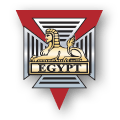Royal Gloucestershire, Berkshire and Wiltshire Regiment
| Royal Gloucestershire, Berkshire and Wiltshire Light Infantry | |
|---|---|
|
Cap and back badges of the Royal Gloucestershire, Berkshire and Wiltshire | |
| Active | 1994-2007 |
| Allegiance |
|
| Branch |
|
| Type | Line Infantry |
| Role | Light Role Infantry |
| Size | 1 Battalion |
| Part of | Light Division |
| Garrison/HQ | 1st Battalion - Chester |
| Colors | PUC carried on regimental colour |
| March |
Quick - The Sphinx and the Dragon Slow - Scipio |
| Commanders | |
| Last Colonel-in-Chief | HRH The Duke of Edinburgh |
| Colonel of the Regiment | General Sir Kevin O'Donoghue KCB CBE |
| Insignia | |
| Arm Badge |
Distinguished Unit Citation From Gloucestershire Regiment |
The Royal Gloucestershire, Berkshire and Wiltshire Regiment was a short-lived infantry regiment of the British Army.
History
The regiment was formed in 1994 by the amalgamation of the Gloucestershire Regiment and the Duke of Edinburgh's Royal Regiment (Berkshire and Wiltshire).[1]
It was the only regiment in the British Army whose members were permitted to wear a cap badge on both the front and the rear of their headdress. The back badge was awarded to the 28th Regiment of Foot for their actions at the Battle of Alexandria in 1801 when the regiment fought on whilst completely surrounded by the enemy.[2]
The regiment was also unique in the British Army in that it was permitted to wear the United States Presidential Unit Citation, which it inherited from the 1st Battalion, Gloucestershire Regiment which was awarded for their defence of Gloster Hill during the Battle of the Imjin River in April 1951 during the Korean War.[3]
Between 2002 and 2005, the 1st Battalion, Royal Gloucestershire, Berkshire and Wiltshire Regiment served as a public duties battalion in London, where its duties included providing the Queen's Guard. It was while the RGBW was on guard at Buckingham Palace that the Fathers 4 Justice protest took place.[4]

On 16 December 2004, the Ministry of Defence announced a reorganisation of the infantry regiments. In preparation for this, the regiment was moved from the Prince of Wales' Division to the Light Division and renamed the Royal Gloucestershire, Berkshire and Wiltshire Light Infantry in July 2005.[5]
On 24 November 2005, the Ministry of Defence announced further changes to the amalgamations. The regiment would amalgamate with the Devonshire and Dorset Regiment, the Royal Green Jackets and The Light Infantry to form a new large regiment to be called The Rifles. The new regiment came into existence in 2007.[6]
The Colours of the 1st Battalion were laid up at The Soldiers of Gloucestershire Museum in Gloucester and the Colours of the 2nd Battalion were laid up at the Wardrobe, home of The Rifles (Berkshire and Wiltshire) Museum in Salisbury.[7]
Alliances
 Canada - The Royal Canadian Regiment
Canada - The Royal Canadian Regiment Canada - The Lincoln and Welland Regiment
Canada - The Lincoln and Welland Regiment Canada - The Algonquin Regiment
Canada - The Algonquin Regiment Australia - 11th/28th Battalion, The Royal Western Australia Regiment
Australia - 11th/28th Battalion, The Royal Western Australia Regiment Pakistan - 13th Battalion, The Frontier Force Regiment
Pakistan - 13th Battalion, The Frontier Force Regiment Kenya - 3rd Battalion, The Kenya Rifles
Kenya - 3rd Battalion, The Kenya Rifles South Africa - The Cape Town Rifles
South Africa - The Cape Town Rifles Royal Navy - HMS Gloucester
Royal Navy - HMS Gloucester
See also
References
- ↑ "The Royal Gloucestershire, Berkshire and Wiltshire Regiment". Retrieved 24 May 2014.
- ↑ "The Royal Gloucestershire, Berkshire and Wiltshire Regiment: History". army.mod.uk. Archived from the original on 9 January 2007.
- ↑ "Bernard Leroy Martin. 1924 – 1997 (obituary of one of three Bermudians in the Regiment at Gloster Hill". The Royal Gazette. 11 March 1998. Retrieved 24 May 2014.
- ↑ "Newspaper cutting". Retrieved 24 May 2014.
- ↑ "Royal Gloucestershire, Berkshire and Wiltshire Regiment". British Army units 1945 on. Retrieved 24 May 2014.
- ↑ "History of the Light Infantry". Retrieved 26 April 2014.
- ↑ "Regimental Colours". Retrieved 26 April 2014.
External links
- The Official website of the Regimental Association
- BBC News article on the reorganization
- The Rifles (Berkshire and Wiltshire) Museum

